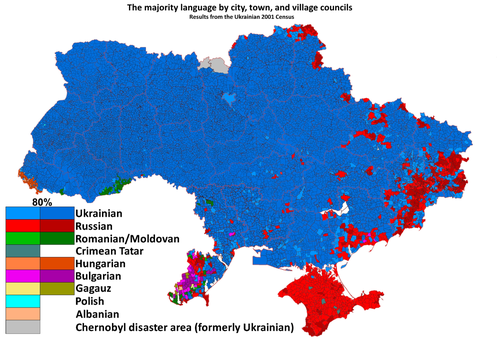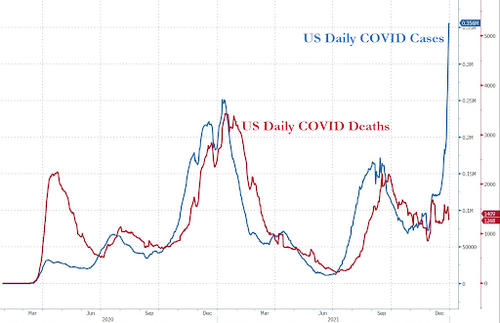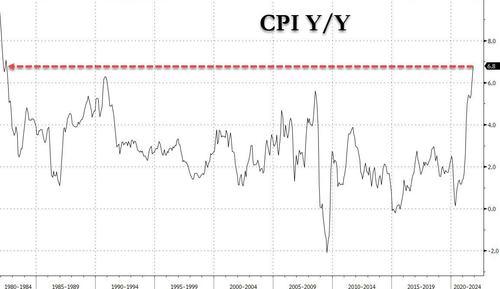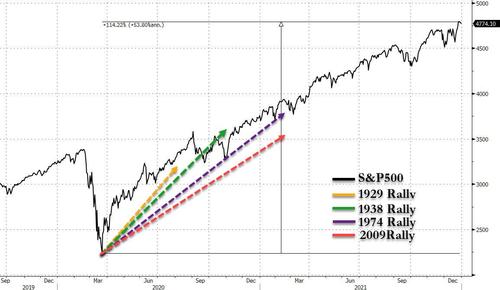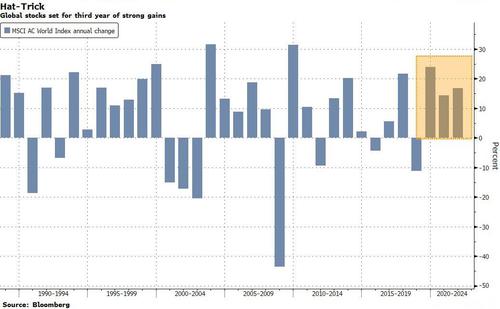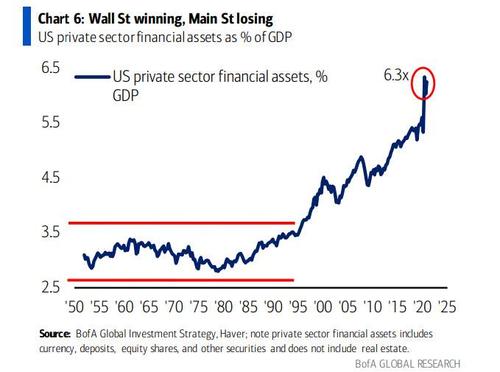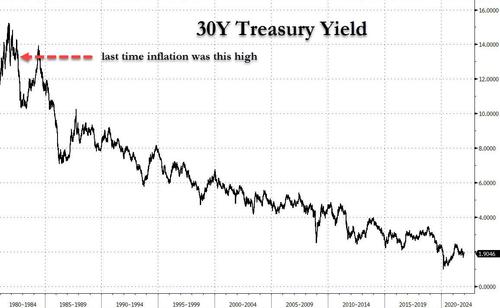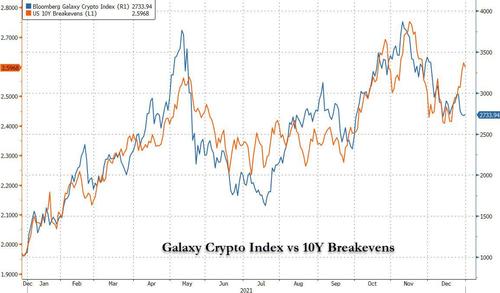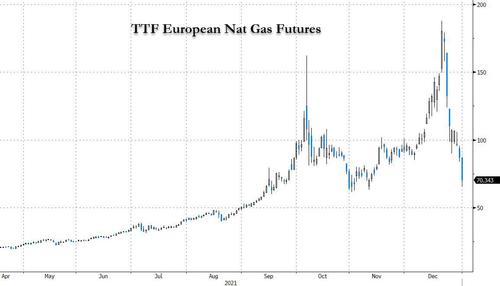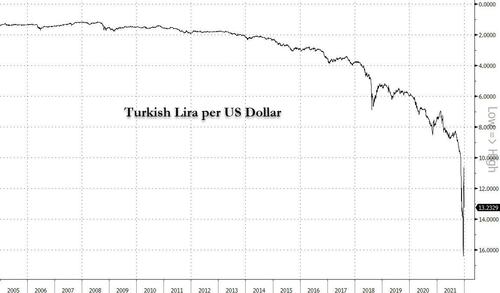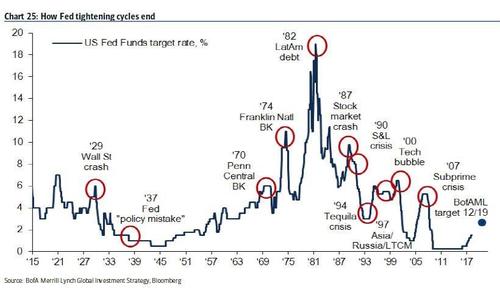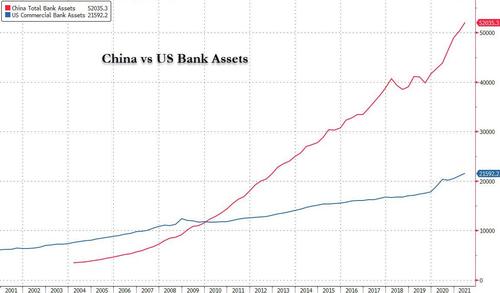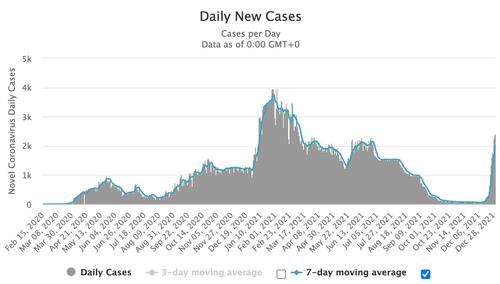Brewery owner Jordan Serulneck remembers feeling the pit in his stomach when he found out the state was ordering him to shut his doors—again. “Our rent was still full price,” recalls Serulneck, the co-owner of Seven Sirens Brewing Co. in Bethlehem, Pennsylvania. “We have a loan with a bank, and that still had to be paid.”
It was November 23, 2020, three days before Thanksgiving. Pennsylvania Gov. Tom Wolf, a Democrat, had just ordered a snap shutdown that required bars and restaurants to close on “Thanksgiving Eve” to prevent gatherings that might spread COVID-19. The fact that Seven Sirens had scraped together more than $10,000 to convert an outdoor space into a heated patio ahead of the winter didn’t matter; the governor’s order banned both indoor and outdoor dining.
When the pandemic hit in March 2020, just a few weeks after Seven Sirens had first opened in mid-February, Serulneck complied with the state’s shutdown order. The promised “15 days to slow the spread” turned into weeks, then longer. It wasn’t until months later that any bars, restaurants, or breweries were allowed to reopen for in-person service. Then came the Thanksgiving shutdown, and then another the following month, this time banning indoor dining from December 11 until after the start of the new year.
When Wolf imposed those new shutdowns late in 2020, Serulneck wasn’t the only business owner to groan—or to shrug. Hundreds of Pennsylvania businesses defied the edicts. Some were punished with fines and threatened with loss of their licenses. Serulneck recalls a TV news van that was parked outside Seven Sirens on the night before Thanksgiving “to see if we were going to be hauled out in handcuffs” for flouting the governor’s order.
Thankfully, it didn’t come to that. But Pennsylvania was hardly the only state where a governor took drastic action to curtail commercial and social activity during the pandemic—not just when it began but months after the risks of gathering and dining indoors were well known to anyone who might voluntarily visit a brewery, restaurant, or store.
Andrew Cuomo, then New York’s governor, set curfews and mandated that bars sell food if they wanted to serve alcohol. Michigan Gov. Gretchen Whitmer banned stores from selling anything other than “products necessary to maintain the safety, sanitation, and basic operations of residences.” Many states imposed sweeping mask mandates by executive order rather than through the legislative process.
Governors generally enjoy broad powers during emergencies, which allow them to command the state government in response to a terrorist attack, a hurricane, or, yes, a pandemic. But an emergency is, by definition, a discrete, time-limited event: an immediate crisis that requires an immediate response.
The COVID-19 pandemic has challenged our understanding of what counts as an emergency and when the special powers it triggers should no longer apply. Emergency powers are supposed to give governors the ability to respond quickly to unexpected circumstances. But at some point after the initial crisis has passed, doesn’t an emergency transform into an issue that can be dealt with via the normal channels of government?
“If you were to use medical terminology, you’d say it goes from being an acute issue to a chronic one,” says Meryl Justin Chertoff, executive director of the Project on State and Local Government Policy and Law at Georgetown Law School. “When does it stop being a disaster in the sense that we need decisive executive action, and when does it start becoming something that requires the more deliberative steps of legislative action, or at least consultation between the governor and legislature?”
Many state legislatures grappled with that issue in 2021, as more than 300 measures to limit governors’ unilateral emergency powers were proposed in 45 states. Such measures have been approved in at least a dozen states—including Pennsylvania, where lawmakers and the state’s voters approved a pair of constitutional amendments restricting emergency powers. Those laws, in turn, have sparked opposition from governors’ offices and from the public health community, which overwhelmingly backed 2020’s harsh lockdowns.
These debates speak to fundamental questions about how democracies should approach not only the COVID-19 pandemic but other problems, ranging from homelessness to climate change. Does effective government require quick, centralized decisions, or should it rely on deliberation and decentralization?
At a time when governments at all levels seem to veer from crisis to crisis as a means of getting things done, this new wave of laws is a reminder that a serious, ongoing issue is not the same as an emergency that justifies setting aside the usual lawmaking process. Put another way, there is a difference between giving a governor the power to respond to a deadly disease at the outset of a pandemic and, six or eight months later, giving that same person the power to unilaterally decide on Monday that bars must close on Wednesday night.
“You just think, ‘How much longer can this go on?'” Serulneck says, remembering how his brewery was forced to weather a pandemic as well as the whims of the state’s chief executive. “How many more times are we going to go back and forth?”
Consent of the Governed
If it was going to go on much longer, Wolf would have to get the consent of the governed. “The citizens of Pennsylvania should have a say in reining in this extended, unilateral power on display during this emergency,” Pennsylvania Senate Majority Leader Kim Ward (R–Westmoreland County) said on the state Senate floor in January 2021, as she announced a new plan to give the legislature a more prominent role in statewide emergencies. “They are the ones who suffer the consequences when checks and balances don’t exist.”
For the first 11 months of the pandemic, those checks and balances were indeed out of whack. Wolf’s initial emergency order, issued in March 2020, was supposed to expire after 90 days, but it had been renewed by the governor on four occasions and was still in force. He ordered schools closed and banned “non-life-sustaining” businesses from operating.
The specifics were at times confusing. Truckers were allowed to work, but truck stops were shuttered. Small businesses whose products were deemed nonessential, such as furniture stores, were ordered to close, even though big-box retailers like Walmart were still free to sell chairs and tables alongside “essential” items. Laundromats were closed, leaving some Pennsylvanians without the means to wash their clothes, but they were free to buy booze from state-owned liquor stores. One of Wolf’s economic advisers quit in protest, blasting the governor for the “devastating economic fallout your decisions have wrought on our state” in his resignation letter.
In Pennsylvania and elsewhere, the pandemic made it clear that “states have these very broad emergency powers available to governors with very little in the way of limitations,” says Daniel Dew, director of legal policy at the Pacific Legal Foundation, a nonprofit libertarian law firm.
The state legislature tried to play its role to little avail. In June 2020, both the House and the Senate approved a resolution that put an end to Wolf’s emergency declaration from March. But the governor claimed he had the authority to veto that measure, thanks to unclear wording in the original statute regarding the governor’s emergency powers.
The state Supreme Court sided with Wolf, effectively imposing a requirement that two-thirds of both chambers vote to end an emergency declaration. It would have been easier to impeach the governor—a maneuver that requires only a simple majority in the state House and a supermajority in the state Senate—than to end his emergency powers.
And so, nearly 10 months after the pandemic hit, Ward decided to try a different tactic. Pennsylvania’s constitution allows the legislature to propose constitutional amendments, which must be ratified or rejected by voters. Ward’s proposed amendment, contained in Senate Bill 2, limited emergency declarations to 21 days and required an affirmative vote from the legislature to renew them.
One advantage of this approach: In Pennsylvania, the governor does not have the power to veto a proposed constitutional amendment. It goes straight from the legislature to the ballot to the voters.
As the first year of the pandemic came to a close, similar debates were roiling many state capitals. In Kentucky, the Republican-controlled legislature clashed throughout the early spring with Democratic Gov. Andy Beshear, who in November had reimposed a mandate closing schools, bars, and restaurants and limiting groups at weddings, at funerals, and in offices. On Easter Sunday in 2020, Beshear sent state police to stop a few church services.
The Democratic governors of Kansas and North Carolina faced similar rebukes from GOP-controlled legislatures.
According to a Kaiser Health News report published in mid-September, legislators in at least 26 states had passed laws to limit public health decrees since the start of the pandemic. That count includes rules limiting governors’ executive power, but it also includes states where lawmakers have exercised arguably excessive powers themselves by banning private businesses from imposing mask or vaccine mandates on employees and customers.
Not all of the clashes between legislatures and governors were motivated by partisanship. In several states, Republican lawmakers led the charge against emergency powers wielded by Republican governors—including Idaho Gov. Brad Little, who renewed his COVID-19 emergency order a whopping 10 times before state lawmakers put an end to it. In Indiana, Republican Gov. Eric Holcomb sued state legislators after they passed a law limiting his emergency powers during the pandemic. The courts upheld the new restrictions on his authority. In March, the Democrats who controlled New York’s legislature struck down several of Cuomo’s emergency orders.
On the other hand, some state lawmakers have been happy to pass off responsibility to the executive branch. Connecticut’s legislature has voted six times, most recently in October 2021, to extend Democratic Gov. Ned Lamont’s emergency pandemic powers.
Preparing for Next Time
Many of the efforts to restrict gubernatorial emergency powers kicked off in spring 2021, and a similar flurry of activity could happen in early 2022. That probably has more to do with logistics than anything. Many state legislatures are in session for a limited period of time, mostly in the first half of the year. Those sessions had been disrupted in 2020 by the start of the pandemic, so early 2021 presented the first opportunity for serious legislative consideration of what to do next. But the timing also reflected the frustration of state lawmakers who had been largely cut out of key decisions for the better part of a year—and who had been hearing plenty of complaints from pandemic-weary constituents.
In a democracy, Georgetown’s Chertoff says, “it is problematic to have governors doing so much for so long by executive order.” She adds that bringing lawmakers into the process earlier might have helped avoid some of the politicization that has plagued the pandemic response. If members of both parties had voted to approve restrictions on businesses or to mandate mask wearing, it would have been harder to treat those policies as partisan issues.
But states entered the pandemic with broad emergency-power laws already on their books. Those laws were not crafted with a yearslong health crisis in mind.
The Idaho legislature granted “tremendous power” to the governor when it passed an emergency-power law in the 1960s, inspired by fears of a nuclear attack that would disrupt the normal functioning of government, Idaho state Rep. Jason Monks (R–Meridian) told the Associated Press in March. He said the pandemic “was the first time, I think, that those laws were really stress-tested.” A few weeks later, the Idaho legislature voted to impose a 60-day limit on the governor’s emergency declarations.
Pacific Legal’s Dew has advised some state lawmakers on the finer points of rewriting the laws governing emergency powers. They have included legislators in Kentucky, where one of the most significant reforms was passed in 2021.
When Kentucky’s emergency-power law was enacted in 1998, it did not include a mechanism for the state legislature to intervene in a disaster declared by the governor. The state’s legislature meets for only a few weeks every year, and only the governor can call a special session to deal with a crisis. While that arrangement was obviously tilted toward executive power, prior to the pandemic it was overwhelmingly used in response to severe weather events: 46 of the 57 previous declarations were related to storms, according to 2020 research published by the Pegasus Institute, a free market think tank in Louisville.
“When the levies broke in New Orleans, that was an emergency,” says Josh Crawford, executive director of Pegasus, which backed the reform effort in Kentucky. “But actually rebuilding the city afterwards, that was a question for traditional governance.”
Crawford says “a lot of people, rightly, gave these governors a tremendous amount of leeway” in the early stages of the pandemic, when no one really knew what was going to happen. By the end of 2020, however, the world was grappling with a different set of questions and contemplating a much longer time period. “You’re no longer really talking about an emergency,” Crawford says. “You’re talking about an important policy question, and we have a procedure in place for dealing with important policy questions—but it’s not government by executive fiat.”
To restore balance, state lawmakers in Kentucky passed what is so far the most aggressive limitation on gubernatorial emergency powers since the pandemic began. A three-bill package initially passed in January 2021 caps emergency declarations at 30 days and requires legislative consent—which can subsequently be revoked at any time—for an extension. The bills also prohibit the governor and attorney general from suspending state laws during an emergency and forbid emergency declarations that impinge on the right to worship or protest. Once an emergency declaration expires or is ended, a “substantially similar” one cannot be issued for 90 days.
Beshear vetoed the bills, but the state legislature overrode his veto in mid-February. A state district court issued an injunction against the new laws after Beshear argued that they would undermine Kentucky’s response to the pandemic and cause avoidable deaths. But the Kentucky Supreme Court overturned that injunction in September and told the district court to rehear the case on the merits. While that legal back-and-forth was playing out, the state legislature agreed to extend Beshear’s emergency pandemic powers until June 21, after which they were terminated.
“The Supreme Court has confirmed what the General Assembly has asserted throughout this case—the legislature is the only body with the constitutional authority to enact laws,” House Speaker David Osborne and Senate President Robert Stivers, both Republicans, said in a joint statement on August 21, shortly after the state Supreme Court blocked the injunction against the law.
The outcome in Kentucky obviously has implications for the remainder of the COVID-19 pandemic. But this kind of law matters for other reasons too. State lawmakers must decide whether the next crisis, when it inevitably arrives, will play out the same way this one has.
Public Health Power Grab
That governors have fought legislative attempts to curtail their power is not surprising. But some of the loudest opposition to emergency-power reforms has come from the public health establishment.
In state after state, public health officials have lined up to defend arbitrary and aggressive pandemic rulemaking against the constraints of the democratic process. In doing so, they’ve defended both Democratic and Republican administrations, showing a bias toward unilateral power rather than any particular political party.
In Ohio, for example, representatives from 18 county health departments and four city health departments testified in February 2021 against a plan to strip some emergency powers from Republican Gov. Mike DeWine. State lawmakers ignored that opposition and approved a bill that limits future emergency declarations to no more than 30 days and prohibits governors from issuing stay-at-home orders or closing businesses. In response, the public health experts escalated their rhetoric. “Each hurdle that favors a lack of public health response,” Mark Cameron, an immunologist at Case Western Reserve University, told the Ohio Capital Journal, “will cause infections and death.”
In May, the National Association of County and City Health Officials and the Network for Public Health Law published a joint report decrying legislative efforts to weaken governors’ emergency powers during the pandemic. “Dissatisfaction and anger at perceived overreaches by governors and public health officials in response to the COVID-19 pandemic has led to an onslaught of legislative proposals to eliminate or limit the emergency powers and public health authority used by these officials,” the groups said in an official statement. “It is foreseeable that these laws will lead to preventable tragedies.”
The public health response to these bills has accurately described the circumstances—in this case, the voter dissatisfaction that is motivating the reforms—while exaggerating the potential consequences of deviating from the course plotted early in the pandemic. Public health officials have been useful in projecting the course of the pandemic and in developing mitigation strategies. But their recommendations, from the initial lockdowns to today’s stay-masked-even-if-you’re-vaccinated guidelines, have routinely failed to account for the practical, human considerations that are a fundamental part of crafting policy.
The May report specifically criticized a new Kansas law—passed by the Republican-controlled legislature and signed by Gov. Laura Kelly, a Democrat, without the drama that marked similar actions in other states—barring the governor from shutting down businesses during a pandemic. Protecting the rights of business owners to not have their livelihoods upended by executive fiat would “allow super-spreader venues” to operate, the two public health groups warned ominously.
Imposing time limits on emergency declarations and giving state legislatures a say in whether the declarations continue is “undermining public health authority” and “will jeopardize health and safety,” the groups added. They also warned that reining in the public health power grab would make it more difficult to “advance health equity during a pandemic.”
During an October interview with a local TV station, Washington’s Democratic governor, Jay Inslee, provided a perfect example of the problems with the top-down approach that public health authorities have championed. More than a year and a half after the pandemic began, people have figured out their own strategies for managing risk and coping with the disease. But Inslee sees it differently: “There is only one person in the state of Washington who has the capability to save those lives right now, and it happens to be the governor of the state of Washington,” he said.
Asked whether legislators should play a larger role in making policies like vaccine mandates, Inslee said it wasn’t possible “because we need to act right now.” Asked when the crisis might be deemed to have passed, at least to the extent that would allow lawmakers into the process, Inslee said he couldn’t be sure “because there are so many metrics to look at.”
“If we make decisions today with some metric that doesn’t make sense after the virus mutates, we could be making some bad decisions and losing thousands of lives,” he said. “We have to depend on the best science that now exists—and it changes as we learn about this, as the virus mutates.”
This sort of open-ended crisis that leaves the legislature out of the equation breaks the feedback loop that representative democracy relies upon. It also ignores the role that individual decision making plays in mitigating the effects of a deadly disease, presuming that people would be utterly helpless without the government to protect them.
And if the best argument for unilateral emergency powers is that they allow a state to be nimbler in responding to an evolving threat, then there should be evidence that states with stronger gubernatorial authority have fared better during the pandemic. But that’s a difficult case to prove.
Michigan, Pennsylvania, and Washington were the three states with the most businesses forced to close during the first year of the pandemic, according to data collected by the Bureau of Labor Statistics. But Pennsylvania and Michigan have seen more deaths per 100,000 residents than the national average. It’s true that some states that adopted stricter pandemic policies, including New York and California, have seen some of the lowest death rates during the pandemic (despite early spikes in both places). But the same can be said of Florida, despite widespread media consternation about its relatively laissez faire approach to COVID-19.
In places where elected representatives spent 2021 trying to stuff governors’ emergency powers back into democratically defined boxes, it is undeniable that politics and partisanship played a role. At the same time, state lawmakers (and voters) may have looked at what was happening, seen that it wasn’t working, and decided that something else was needed. That’s not undermining the effectiveness of state government; it’s democracy in action.
Always Another Emergency
COVID-19 is driving the use of emergency powers right now. But Dew worries that states without limits on those powers could find themselves facing other kinds of unilateral edicts in the future. Any one of dozens of quasi-emergencies that supposedly require a response from state governments could invite the sort of open-ended, top-down direction from the governor’s office (or the White House) that has been a hallmark of the pandemic.
“That’s not the way our government is supposed to function,” Dew says. “Emergency powers are there for the governor to steady the ship in the middle of a storm, not to set a new course.”
For special interest groups looking to impose large-scale policy changes that have been stymied by the democratic process or by legal and constitutional issues, the pandemic has not been a warning about the dangers of unilateral executive power. It has been a roadmap. Left-wing activists and even some Democratic lawmakers are increasingly pushing for governors and presidents to exert greater powers to deal with “emergencies” that would more accurately be described as long-term, chronic issues.
“We’ve already seen calls in opinion pages to declare emergencies for things like climate change, homelessness, gun violence, and opiate abuse,” Dew says. “Those are serious issues that the government may choose to address. But if it does, it has to be through the state’s lawmaking body.”
Just a week after Joe Biden was sworn into office, Senate Majority Leader Chuck Schumer (D–N.Y.) called upon the new president to declare climate change a national emergency. “If ever there was an emergency, the climate crisis is one,” Schumer told MSNBC’s Rachel Maddow.
The majority leader was echoing a December 2020 letter to Biden’s transition team from more than 300 groups. It urged the incoming administration to invoke the National Emergencies Act as a remedy for climate change, a move that would give Biden the unilateral authority to impose the policies favored by those groups. Among other things, The Washington Post explained, Biden could use such an order to direct military spending toward green energy projects, ban oil exports, or impose tariffs on countries he thinks are polluting too much.
California provides an example of what that might look like—and why limits on executive power matter. In July 2021, Democratic Gov. Gavin Newsom issued an emergency declaration saying that “the effects of climate change threaten the health and safety of Californians.” He immediately used his new powers to issue 10 pages of rules for California’s electric and water utilities in response to the state’s ongoing drought. In October, he extended that order and gave the state water board the authority to ban car washing and to limit how water is used in everything from construction sites to decorative fountains.
At least Newsom’s ability to enact far-reaching changes via emergency order is limited: In California, unlike many other states, emergency orders issued by the governor automatically end after 60 days. (In contrast, emergency powers seized by presidents under the National Emergencies Act can persist indefinitely, as long as the sitting commander in chief renews them each year. America’s longest-running ongoing “national emergency” was issued by President Jimmy Carter to freeze the assets of perpetrators of the Iranian hostage crisis.)
Prior to his resignation, New York’s Cuomo became the first governor in the country to issue an emergency declaration targeting gun violence. The order, issued in July, redirects $139 million in state spending toward initiatives that are supposed to curtail a spike in shootings since the beginning of the pandemic.
For the most part, that means more policing. Cuomo’s order created a new task force charged with stopping guns coming over New York’s borders. House Speaker Nancy Pelosi (D–Calif.) has expressed support for a similar emergency declaration at the federal level.
But the most notable part of Cuomo’s order is how long it will remain in force: “until further notice.” That’s not a response to an emergency; it’s permanent policy making.
Such abuses are not limited to the political left, Dew notes. President Donald Trump used emergency powers to redirect military funding to his border wall after Congress refused to authorize spending on it. And the Trump administration was responsible for one of the pandemic’s most ridiculous abuses of power: the Centers for Disease Control and Prevention’s nationwide ban on evictions. While the federal ban was overturned by the Supreme Court in August, New York and California maintained their own eviction moratoriums, imposed via emergency orders, as of December 2021.
If past crises such as 9/11 and the subsequent war on terror teach us anything, it’s that even explicitly temporary expansions of government power can easily become permanent. The difference this time around is that fewer people are even pretending their wish list measures are supposed to be temporary, as Cuomo’s “until further notice” mandate on guns demonstrates. Rather than merely steering the ship of state through a storm, governors and presidents are increasingly using threats on the horizon to stay at the wheel.
A Hardball Approach
Pennsylvania is the first (and still the only) state to put a question about the limits of gubernatorial emergency powers before the voters since the start of the pandemic.
Wolf, the Democratic governor, objected to the Republican-controlled legislature’s attempt to cut off his emergency powers via constitutional amendment. Having emergency declarations expire after just 21 days, Wolf said in a January 2021 statement, “would hinder our ability to respond quickly, comprehensively and effectively to a disaster emergency by requiring any declaration to be affirmed by concurrent resolution of the legislature every three weeks. This would force partisan politics into the commonwealth’s disaster response efforts and could slow down or halt emergency response when aid is most needed.” In the event that a disaster somehow prevented the legislature from meeting, he warned, the limit could leave the state with no legitimate leadership.
Despite those objections, lawmakers moved quickly to approve the two amendments and place them on the state’s primary election ballot. “We are not saying that the governor can’t act,” state Sen. Ryan Aument (R–Lancaster) said during the floor debate. “We are simply saying that he can no longer act alone without justifying his actions before the people’s representatives in the General Assembly.”
When Pennsylvanians went to the polls in May 2021, it was the first real test of voters’ attitudes toward pandemic lockdowns. By narrow margins, they approved both constitutional amendments limiting Wolf’s emergency powers.
A few weeks later, on June 8, both chambers of the state legislature used those newly granted constitutional powers to terminate the governor’s emergency order. After more than 460 days, the official “emergency” phase of the pandemic was over.
The pandemic itself, of course, rages on. But the debate about which policies are necessary to control it—lockdowns, mask mandates, vaccine passports, and whatever comes next—should be wholly separate from the debate about how those decisions are made. Democracy is messy, but neither legislatures nor governors (nor unelected public health experts) have a monopoly on the truth, or on the proper balance between safety and freedom.
“The separation of powers matter,” Chertoff says. “They’re supposed to be checking one another.”
She worries that some states may have, for partisan reasons, gone too far in restraining how governors can act in the face of a genuine future emergency. But by refusing to give lawmakers a seat at the table as the weeks and months passed, some governors may have invited a hardball approach. To limit the power of the state, James Madison famously wrote in The Federalist Papers, “ambition must be made to counteract ambition.”
High-minded ideals aside, at Seven Sirens Brewing Co., the passage of the constitutional amendments and subsequent neutering of Wolf’s emergency order brought some relief. Serulneck knows he could be facing another tough winter, but at least another state-mandated shutdown seems to be off the table.
Anyone who walks inside Serulneck’s taphouse in the coming months will certainly be aware of the risks. The new omicron variant is a reminder that COVID-19 is still a crisis—but it’s not an emergency.
Individuals can make their own risk assessments without state intervention. Control-obsessed politicians “have less legal ground to stand on now,” Serulneck says. “When the emergency order powers were stripped, that pretty much put an end to it.”
The post The Lockdown Showdown appeared first on Reason.com.
from Latest – Reason.com https://ift.tt/3sQl6Gj
via IFTTT


